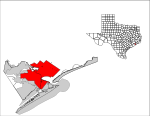Texas City disaster

The 1947 Texas City disaster was an industrial accident that occurred on April 16, 1947, in the port of Texas City, Texas, United States, located in Galveston Bay. It was the deadliest industrial accident in U.S. history and one of history's largest non-nuclear explosions. The explosion was triggered by a mid-morning fire on board the French-registered vessel SS Grandcamp (docked at port), which detonated her cargo of about 2,300 tons (about 2,100 metric tons) of ammonium nitrate. This started a chain reaction of fires and explosions aboard other ships and in nearby oil-storage facilities, ultimately killing at least 581 people, including all but one member of Texas City's volunteer fire department.: 100 The disaster drew the first class action lawsuit against the United States government, on behalf of 8,485 plaintiffs, under the 1946 Federal Tort Claims Act.
Excerpt from the Wikipedia article Texas City disaster (License: CC BY-SA 3.0, Authors, Images).Texas City disaster
2nd Avenue South,
Geographical coordinates (GPS) Address Nearby Places Show on map
Geographical coordinates (GPS)
| Latitude | Longitude |
|---|---|
| N 29.3775 ° | E -94.891388888889 ° |
Address
2nd Avenue South
77590
Texas, United States
Open on Google Maps







